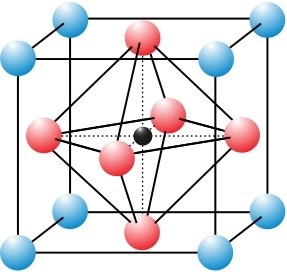Jan 17 2018
Photons with energy superior to the 'band gap' of the semiconductor absorbing them, give rise to what are referred to as hot electrons. The additional energy with regards to the band gap is lost very rapidly as it is transformed into heat, so it does not contribute to the voltage.
 Perovskite structure (Image credit: Korjus - Wikimedia CC BY-SA 3.0)
Perovskite structure (Image credit: Korjus - Wikimedia CC BY-SA 3.0)
University of Groningen Professor of Photophysics and Optoelectronics Maria Antonietta Loi has currently found a material in which these hot electrons preserve their high energy levels for a lot longer. This might make it possible to use more of their energy to attain a higher voltage. Her results can be found in the January 16 issue of Nature Communications.
The efficiency of solar panels is hindered by a Goldilocks setback: photons have to possess just the correct amount of energy to be transformed into free electrons, which add to the voltage. Too less energy, and the photons travel right through the solar panel. Too much, and the surplus energy disappears as heat.
Perovskites
The latter is because of the creation of hot (high-energy) electrons. Before being extracted from the solar cells, these hot electrons first release their excess energy by producing vibrations in the crystalline material of the solar panel. “This energy loss puts a limit to the maximum efficiency of solar cells”, explains Loi.
She is working on a distinct type of solar cell that is produced from organic-inorganic hybrid perovskites. Perovskites have been named after a mineral that comprises the chemical formula ABX3. In the X position, anions develop an octahedron, while in the A position cations produce a cube around them, while a central cation takes the B position. A number of materials in the perovskite family embrace this crystal structure. In the A position, hybrid perovskites comprise of organic cations.
Lifespan
An increasing number of hybrid-perovskite solar cells contain lead, which is considered to be toxic. Recently, Loi's group published a paper talking about a record-breaking nine-percent efficiency in a hybrid-perovskite solar cell comprising of harmless tin instead of lead. 'When we studied this material further, we observed something strange', she continues. The results could only highlight that the hot electrons generated in the tin-based solar cells took almost a thousand times longer than usual in order to disperse their excess energy.
'The hot electrons gave off their energy after several nanoseconds instead of some hundred femtoseconds. Finding such long-lived hot electrons is what everybody in this field is hoping for', says Loi. Their prolonged lifespan allows harvesting these electrons' energy before it becomes into heat. 'This means we could harvest electrons with a higher energy and thus create a higher voltage in the solar cell.' Theoretical calculations demonstrate that by harvesting the hot electrons, it is possible for the maximum efficiency for hybrid-perovskite solar cells to increase from 33 to 66%.
Clean energy
The next step is to discover why the tin-based hybrid perovskite slows down the decay of hot electrons. It is possible to design the new perovskite materials with even slower hot electrons. “These tin-based perovskites could be a game changer, and could ultimately make a big contribution to providing clean and sustainable energy in the future.”
Reference: Hong-Hua Fang, Sampson Adjokatse, Shuyan Shao, Jacky Even and Maria Antonietta Loi: Long-lived Hot-carrier Light Emission and Large Blue Shift in Formamidinium Tin Triiodide Perovskites Nature Communications 16 January 2018.